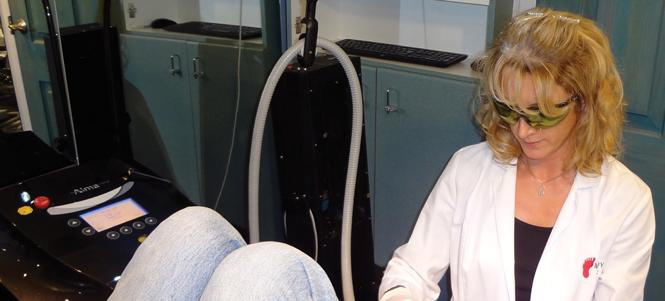A STEP FORWARD
posted: Sep. 20, 2013.
A STEP FORWARD

Whether it’s driving to work, walking to the store or running at the gym, we rely on our feet to do a lot of the work for us. Therefore, it’s important to take extra care of our feet.
Dr. John A. Hardy had this in mind when he founded Academy Foot and Orthotic Clinics in Toronto in 1980. After his wife Marz joined the clinic in 2001, they have continued to offer state-of-the-art podiatric treatments to help their patients improve their stride, posture and overall foot health.
“We are constantly striving to provide our patients with the best possible care using the latest in technology and techniques,” he says. “We are always upgrading our clinical skills by attending the most relevant post-graduate courses and seminars in podiatry and chiropody.”
One of the most common conditions they see in their clinic is nail fungus. Often caused by damaged nails or skin, health conditions such as psoriasis, diabetes and immune deficiency, smoking, and athlete’s foot, nail fungus can cause a significant amount of discomfort.
It is also transmittable, which is why extra caution should be taken in shared spaces such as showers, bathrooms, gyms, locker rooms and swimming pools.
“Fungal infections are often unsightly. With nail fungus, the nail becomes thickened or discoloured… Nails can become brittle or can crumble, and may lift from the end of the digits, and in some cases debris collects beneath the nail and becomes malodorous,” he explains. He says that moisture can often cause the fungus to grow, which is why toenails tend to be more susceptible to nail fungus than fingernails.
Academy Foot and Orthotic Clinics has recently invested in a new laser treatment to treat nail fungus. The Q-Clear Laser by Alma is a groundbreaking FDA-approved treatment that targets the patient’s individuals nails to destroy fungal spores. To continue to destroy the infection, a traditional Nd:YAG laser is also used during the treatment.
“Our laser has been in operation for only a few months, but we are already seeing nails clearing after only a few treatments in nearly all of our patients,” says Marz. “One of my patients who I have been caring for over 10 years has had nail fungus, which was slowly getting worse despite all the creams and fungal remedies we had at our disposal. I never suggest oral pharmaceuticals as the chance of liver and kidney damage is not worth the risk. After only three laser treatments we can see that her nail is now growing out normally and we are certain we have finally found a cure for this patient.”
One of the most common concerns patients tend to have is that the laser treatments are painful. The Hardys reassure them that it is a painless procedure with little to no discomfort. Following the treatment, patients are able to walk and return to their daily routines.
The treatments are usually performed in sets of five, each spaced a month apart. During each treatment, the patient’s footwear is also sterilized with ultraviolet light, and they are provided with tea tree oil, which is known for its antimicrobial properties to prevent the re-growth of fungus.
Marz says that laser treatments are the most effective method to treating nail fungus.
“Nail fungus is almost always quite difficult to get rid of. There are no silver bullets that will make it disappear in a day, week or month. One of the reasons is that fungal infections are a systemic infection and is not just under the skin but usually deep and through many layers of skin,” she explains. “Even with laser it takes time and you have to wait for the infected nail to grow out which usually takes at least nine months. Once it is cured, it can easily come back if the person doesn’t practise proper hygiene and properly care for their feet.”
It is important to look for warning signs of nail fungus, which can include discolouration and change in texture (brittle or thickened nails).
“While some see the fungal infection as purely cosmetic, when the nail becomes thickened, heavily discoloured and crumbly, it can cause significant embarrassment and self-consciousness,” says John. “It can become painful in shoes, develop corns down the sides of the nails and also become impossible to cut or trim, causing ingrown nails. In addition, it becomes a source of nail fungus that can constantly re-infect the skin of the foot.”
Since some patients may be self-conscious of their feet prior to the treatment, nail fungus can heighten this emotion. Therefore, at Academy Foot and Orthotic Clinics, the Hardys offer their patients a comforting and relaxing atmosphere with trusted equipment.
“Our clinic is constantly striving to provide the best possible foot care by using the latest technology and techniques possible,” says Marz. “You will also be warmly greeted by our team of professional health-care providers who love their profession and are dedicated to their patients.”
Dr. John A. Hardy is the owner and office manager of Academy Foot and Orthotic Clinics, where he also works as a consultant. Marz Hardy, D.Ch., B.Sc. (Podiatric Medicine), is a member of the College of Chiropodists of Ontario (CCO), Canadian Federation of Podiatric Medicine (CFPM), Ontario Society of Chiropodists (OSC) and American Podiatric Medical Association (APMA). In 2006, she was also the first chiropodist in Canada qualified in Active Release Technique (A.R.T.).
» academyclinics.com
» 416-465-8737 •